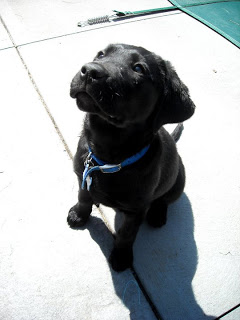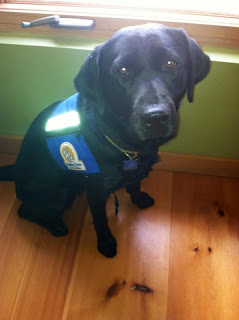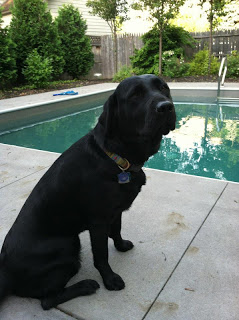Readers who have been with us since the early days on this blog may recall I wrote about my decision to take an emotional courage challenge in the form of raising a guide dog puppy with my daughter, the Lovely K. Here is my report on raising a leader.
Our adorable pup, “F,” came to us in April of 2011 from Guiding Eyes for the Blind. She was a little black bundle of Labrador Retriever love, and we fell in love at first sight. Our family dog, Cider, was delighted to have a little sis to chase around the house, and the games began right away – although while she was small, F sometimes took refuge under a chair. However, it wasn’t long before she matched our dog in size, and then surpassed her. We had an independent spirit on our hands, and when we took little F to puppy play with the other pups on the regional GEB team, she was content to follow her nose through the grass while the other puppies tumbled and played. Her home playmate seemed to be enough for her.
The courage challenge for me, in the early months with this dog, was a real test of my patience and my composure. Raising a family dog is one thing; raising a guide dog is quite another. The protocols and training procedures are not complicated or even much different from basic obedience – but they are inexorable. There can be no exceptions to the rules, no ‘just once can’t she sleep on my bed?’ no, ‘I don’t mind if she jumps up on me at the door.’ The grass in my yard was steadily worn away by two energetic dogs playing chase, and my enthusiasm wore thin on occasions, too.
For my daughter – and her visiting friends – having a pup meant lots of adorable photos and hugs and kisses. As F grew bigger (and stronger) it became clear that walking her was going to fall mainly to me. Although the ideal we were working toward was a gentle dog that would not pull, the ideal wasn’t necessarily what we had in F at 8 months or 9 months! And yet she did steadily make progress, and when we put on the vest that identified her as a service dog in training and took her to the mall, the grocery store, the movie theater, the public library, she seemed to know her role. Twice-monthly training classes with the team exposed her to fire trucks and strange noises and people in funny hats and stairs and elevators and working with new handlers.
By the time she was 14 months old, we had a smart, confident young dog who clearly enjoyed using her considerable brain to solve puzzles and examine new things, but also loved lying at my feet at night in the t.v. room. And although we knew all along that she was not ours to keep, when we were informed of her “in for training” date – the date when she would return to Guiding Eyes for the Blind to begin her serious training in harness – it was a blow to our hearts. Two months away. Then one month. Then two weeks. Then it was tomorrow.
K. and I both sniffed back our tears and wiped our eyes when we dropped her off. Our ride home was silent, and we were brusque with each other for a while, arguing about something entirely different and both feeling an empty F-shaped hole in our hearts. “I miss her,” K. said that evening. “Me, too,” I agreed. She looked at me. “Were you crying?” she asked, as if not quite sure I was upset about the dog.
“It’s okay to cry if you’re sad,” I told her. “There’s no reason to hide it.”
I asked K. several days later how she felt about the experience. “Would you recommend other kids your age do a project like this?”
“Maybe” she said pensively. “Fifty-fifty.”
“How about when you think of how she’s going to change someone’s life?”
K. thought for a moment. “If it’s important to you, like if you care about helping people with disabilities.” She paused. “I tried not to get too attached. But a dog is a dog.”
A dog is a dog, and better writers than I have spoken eloquently about how much a dog can teach about love, attachment, and acceptance. And loss. And moving on. Emotional courage can help us with all of those and more.



